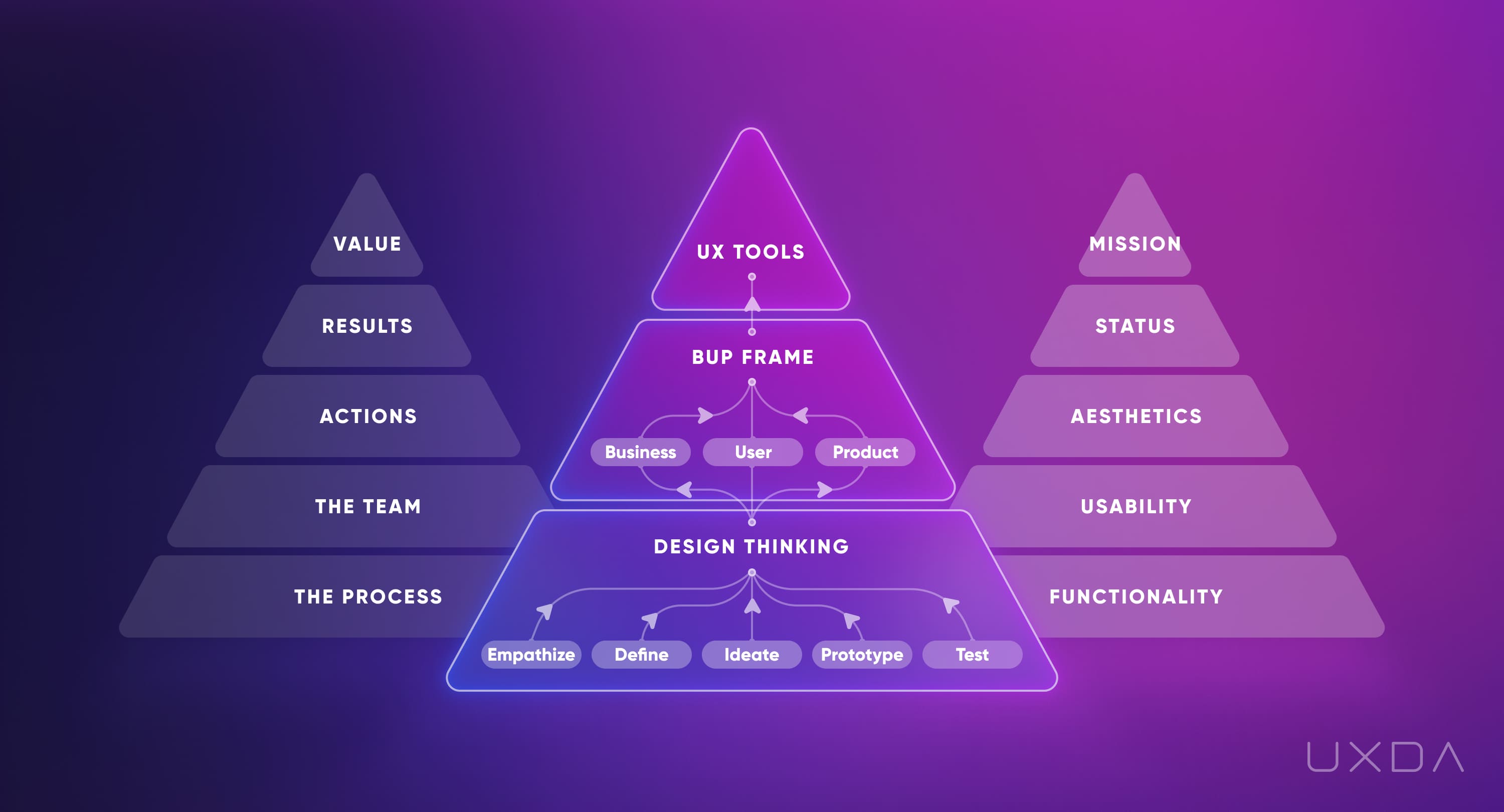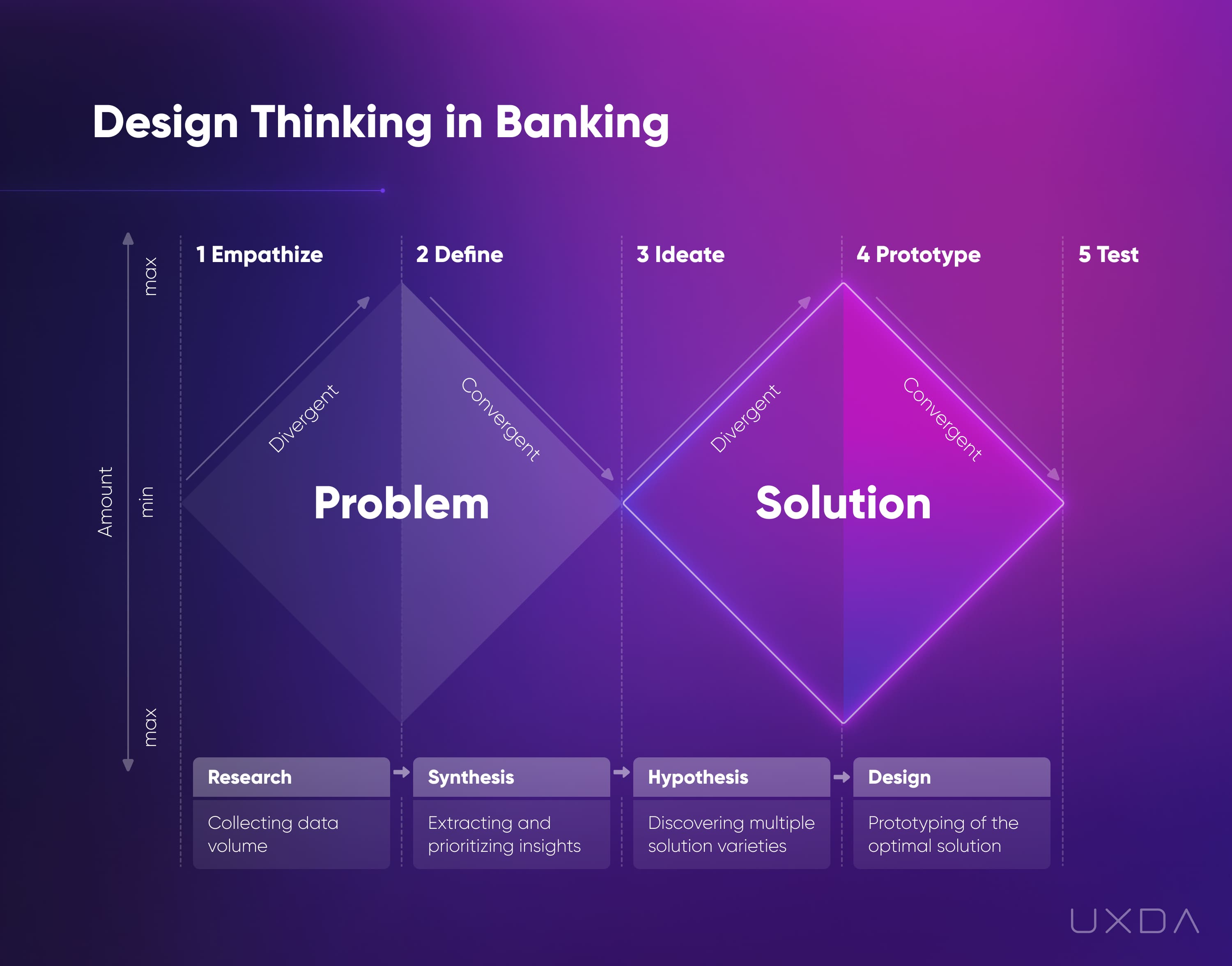Ten UX Strategies for Next-Gen Digital Banking Design
We see hundreds of new skyrocketing fintech startups and challenger banks. They work hard on usability and design the best financial user experience (UX) to build the next generation of financial products. At the same time, some products of incumbent banks and other financial institutions lag far behind in terms of design and usability. What can sabotage the creation of next-generation financial products, and how can this be overcome?
How to Move to a Next-Gen Financial Product Design
By switching from a legacy approach to a next-gen, customer-centered design approach, banks could ensure customers an exceptional digital experience according to their expectations. Because with the rise of digital services, customers have become accustomed to delightful, seamless, easy-to-use digital experiences. And here are ten UX strategies to switch a financial institution team to a next generation product design approach:
1. View Design as a Methodology, not as a Package
Next-gen approach: design is a customer-centered business approach
Legacy approach: design is a package
There's an outdated belief in the financial industry that design is an eye-catching marketing tool to trick customers into buying. Things have changed in the digital age; now design ensures the success of the financial brands through a customer-centered business approach.
To realize their full potential, Fintechs and progressive banks know that design is not a tool, it is a process that involves the whole team of the company in seeking and executing innovative ideas on how to solve customer problems. It's an approach for creating demanded digital products that would live up to the customer’s needs and expectations.
There are five areas successful financial brands focus on to use UX design as an accelerator of the company's success:
- Business model that puts the processes of user-centricity first;
- Team of UX experts who are qualified to execute the business idea and make sure it will truly bring value to the customers;
- Right actions executed by the UX experts who are able to impact in-depth processes of the financial company;
- Correct criteria to evaluate the results the team is producing - whether the focus is on the packaging or delivering exceptional experience;
- The materialization of the unique Value the financial app will provide to the customers, turning the brand into a success story.

2. Increase the Scope of UX Design Influence
Next-gen approach: designers are UX facilitators, empowering customer-centricity in business processes
Legacy approach: designers create only the top coat of the product
The skills and expertise of the world's best UX designers and experts will be worthless if their influence is limited to visual appearance. To empower the design potential of Financial companies, UX experts become design facilitators, implementing user-centered thinking into every company process, and coaching employees to become customer advocates.
Fintechs and progressive banks empower the design potential through outsourced design competence like experienced financial design consultants, agencies and coaches.
The number of benefits that the product can offer and the speed of its realization often depend on the scale of actions and the vision of the design advocates on the team. This can be facilitated to a large extent if one or more of the C-level executives are passionate about increasing the products' and company’s value through a user experience design approach and Design Thinking in banking.

3. Challenge the Past
Next-gen approach: agile, flexible and quickly adapting to future rules
Legacy approach: relying on past success
The new age requires the ability to adapt quickly. The recent COVID-19 crisis was a clear example of it. Those who reacted bravely managed to keep their clients, while others who stuck protecting their legacy failed.
Incumbents are often focused on protecting their legacy and maintaining the corporate image. That's why any new changes may come slowly and painfully. It is self-evident that this legacy is holding them back. That's why implementing new technologies doesn't save incumbents from losing clients.
The design approach guides their teams through the necessary methods and tools. This way, the company's employees aren't wasting their energy on protecting the market share of an unsuccessful product but, rather, focusing on designing a financial product that exceeds user expectations, guarantees customer loyalty and leads to an organic increase in popularity without spending enormous marketing budgets.
Fintechs and progressive banks are completely immersed in the customer’s problem to find the best solution. They are aware of the complexity of the task and the fears that naturally go with it, but these companies know that legacy holds them back, so they gather all of their courage to step over it.
4. Switch from Fragmentation to Ecosystem
Next-gen approach: developing a holistic digital ecosystem
Legacy approach: developing products separately
A mistake that many incumbents make is that they try to digitize their products separately. Having different departments each working on their product creates fragmentation. This leads to a broken customer experience as users perceive the experience of banking services as a holistic flow, not separate elements.
To avoid this, the employees of progressive financial brands work side-by-side to improve the customer experience that connects all of their products into a united, user-friendly ecosystem.
A practical way to make this happen is to create a complete UX/UI design system. It ensures that everyone working on the ecosystem products is on the same page and can quickly develop consistent digital solutions in their specific field of responsibility. Most importantly, in this way, the customer will be able to enjoy the end result as all banking products will have the same intuitive and user-friendly functioning principles.
5. Put UX Research First
Next-gen approach: the main focus is on the users
Legacy approach: the main focus is on products
Successful financial companies know that mobile banking apps created without proper user research often fail, because it's not possible to address market needs if there's no knowledge about the user problems.
They first find out the user’s context and then create a value proposition. This process doesn't end after the launch of the Fintech or banking app. They regularly collect customer feedback from social networks, App Store and Google Play, improving the product accordingly.
Before building the product, they always start with user research and user experience engineering. They constantly explore users' feedback, thus finding a lot about their customers' pain points, and are constantly improving those. The executives and employees regularly discuss customer reviews and actively ask their opinion to gain insights about customer needs and pains and seek ways how the product can solve them.
6. Provide a Unique Value Proposition
Next-gen approach: creates an authentic value
Legacy approach: believes that one size fits all
What is the “WHY” behind financial services? Many incumbents make a profit that doesn't address the customer's needs.
The marketing thinking “one size fits all” is long gone. Unique solutions create emotions. And emotions drive the value of the product and the loyalty of the clients, resulting in conversion.
This is possible by carefully empathizing with the users and analyzing the competitor’s mistakes and successes.
7. Drop the Obsession with Functionality
Next-gen approach: aims for fewer functions that better match the users’ needs
Legacy approach: thinks that the more functions, the better
For many incumbents, featuring sometimes feels like an obsession. They believe the more features, the greater the probability of product success. Actually, it's the opposite.
They strive for a simple-to-use product and avoid overfeaturizing because that confuses users. These kinds of companies carefully evaluate all the features and eliminate those without value for the user.
Here it's important to carefully evaluate all the features and eliminate those that have no value for the user.
8. Measure the Result by the Quality, not Quantity
Next-gen approach: measures results by the value that design brings to the customers
Legacy approach: counts design deliverables
Success depends on how it's measured. Some incumbents often focus on the number of interface screens designed per day.
The product quality of incumbents might be sacrificed for speed and quantity. This might seem like a win in the short term, but, in the long term, the support team starts receiving thousands of calls about similar struggles.
Fintechs and progressive banks are ready to sacrifice delivery speed to gain best quality. Their service designers and architects think through every tiny detail, even if it slows the overall design process.
Successful financial brands know that the correct outcome criteria define the level of value a product is able to provide for the users. It's not the number of screens that is important, it is the quality of the screens.
Only the compliance of the financial product design with the key user scenarios can make it more understandable and enjoyable for the customers. Naturally, it requires the investment of more time and resources into analysis, research and UX architecture. Therefore, it is very important that this process is carried out by experienced specialists.
9. Focus on Emotions Instead of Information
Next-gen approach: ensure an emotional connection with customers
Legacy approach: focus on advertising and information
Users forget information but remember experiences, and experiences are created from emotions. That's why Fintechs and progressive banks integrate information into a context of usage, so it becomes an organic part of the banking user experience.
To achieve this, they focus on emotions that the brand itself and the product delivers, using intuitive information architecture and a delightful UX design to manage it. They use customer experience design methodology to explore and connect with their users emotionally.
10. Invest More in Improving Customer Experience
Next-gen approach: focus on how to serve customers through a purpose-driven approach
Legacy approach: focus on how to make more profit in any way possible
There are two strategies to attract digital customers. Incumbents tend to focus all efforts on marketing and large-scale advertising campaigns.
“Win-win” scenarios in which the main aim is to help customers, instead of manipulating them, will pay off with customer loyalty and referrals.
Making human-centricity a cornerstone of the financial company values and culture, makes the service a magnet that attracts customers and ensures the financial brand's success.
Source: UXDA
Collected by the author DTSVN team - Digital transformation solutions for the Finance - Banking
-------------
DTSVN is a pioneering Digital Transformation Company providing the latest digitization solutions exclusively for businesses in the Finance - Banking field in Vietnam; helping banks and financial institutions quickly complete the technology system for Digital Transformation.
Contact us now and experience our significant software solution here.